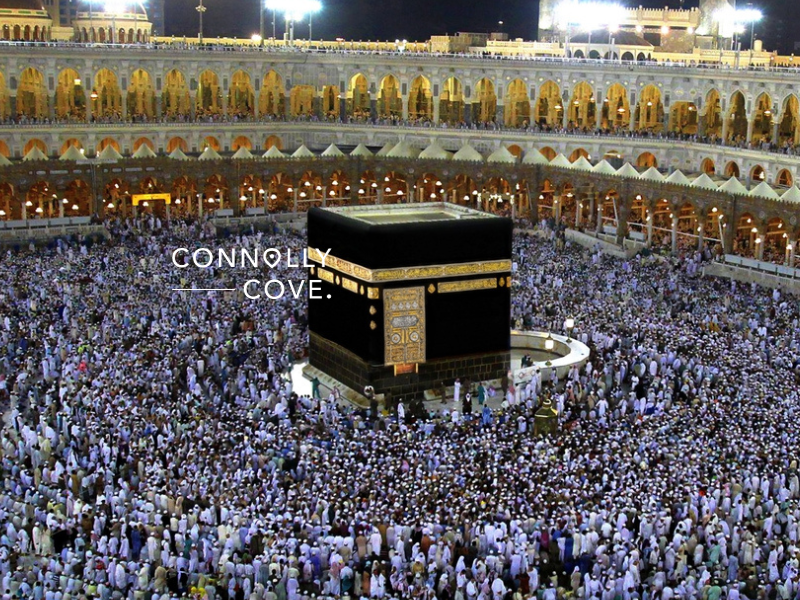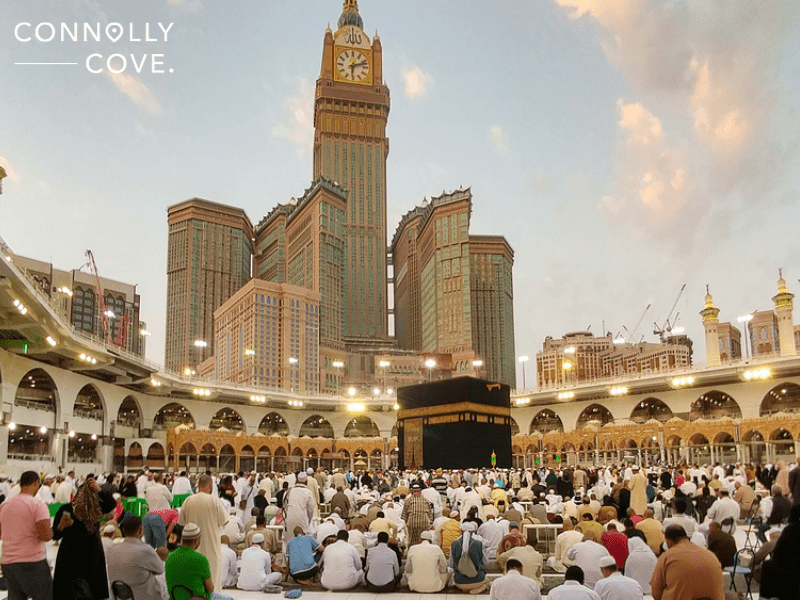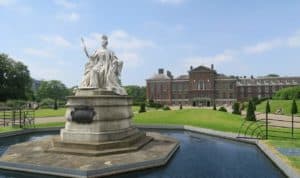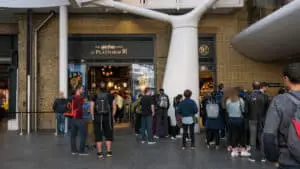Where is Mecca? Your Guide to Discovering the Location of the Holiest City in Islam

Updated On: December 07, 2023 by Raghda Elsabbagh
Have you ever found your mind wandering towards the exact location of Mecca, that iconic city held sacred in Islam? Well, rest assured, mates, you’re in good company—we, too, have been captivated by this spiritual heartland and dedicated much time to unlocking its enigmas.
In this blog, we shall embark on an intriguing journey to discover everything from Mecca’s geographic stationing within Saudi Arabia to its profound historical importance as Prophet Muhammad’s birthplace. So fetch your virtual passports, chums; a thrilling voyage beckons!
Key Takeaways
- Mecca is located in the Hejazi region of Saudi Arabia.
- It holds great significance as the birthplace of Prophet Muhammad. It is home to the holiest structure in Islam, the Kaaba.
- Mecca’s layout includes iconic landmarks like Masjid al-Haram, which can accommodate millions of worshippers during peak times.
- The city’s proximity to Medina allows for combined visits during Islamic pilgrimages.
Geographic Location

Let’s start our journey by pinpointing the heartbeat of Islam—Mecca. In the cradle of the Arabian Peninsula, Mecca is nestled in the western region of Saudi Arabia, at approximately 21.3891° N latitude and 39.8579° E longitude. These magical coordinates place Mecca on the world map, marking it as a sacred space for millions around the globe.
Now, let’s zoom out and see how Mecca fits into the grand tapestry of Saudi Arabia. The city is located in the Hejazi region of Saudi Arabia, about 70 km (43 mi) inland from Jeddah. It sits in a narrow valley at a height of 277 metres (909 ft) above sea level. This holy city finds itself cradled by the rugged Sarawat Mountains and the embrace of the Arabian Desert, creating a natural amphitheatre of beauty.
Mecca stands proudly in the west, not far from the shores of the Red Sea. Its location near the Red Sea coast makes it easily accessible for pilgrims arriving by boat or plane. This strategic location makes it a focal point for religious pilgrims and a cultural hub connecting various cities and regions. The city’s proximity to Medina also allows for combined visits during Islamic pilgrimages.
Climate in Mecca
The climate is hot and arid most of the year, with temperatures soaring above 40 degrees Celsius during the summer months. It experiences very little rainfall throughout the year, making it a desert region. Despite these challenging conditions, millions of pilgrims travel to Mecca annually to fulfil their religious duties.
Mecca’s Layout and Prominent Landmarks
Mecca is nestled in a narrow valley, surrounded by the majestic Sarawat Mountains. One of the most iconic landmarks there is the Masjid al-Haram, which houses the holiest structure in Islam, the Kaaba. This monumental mosque can accommodate millions of worshippers during peak times, making it the largest mosque in the world.
Another notable site is Jabal al-Nur, or the Mountain of Light, where you can find Hira cave. This cave holds great significance as it was here that Prophet Muhammad received his first revelation from Allah (God). This message started the growth of Islam as we know it today.
As you explore Mecca’s city streets and navigate this spiritual hub, you will encounter bustling markets filled with vibrant colours and exotic scents. Rich with history and deeply rooted in Islamic culture, the city offers an unforgettable experience for visitors seeking to immerse themselves in the Muslim faith and heritage.
Mecca Before the Advent of Islam
Long before the golden rays of Islam touched the sands of this sacred city, Mecca was a busy trade city in the heart of the Arabian Peninsula. It was the beating heart of old trade routes crisscrossing the Arabian Desert. Merchants came from far away to buy and sell goods here. They wove through the city, bringing spices, textiles, and stories from distant lands. This made the ancient city rich and famous. Its economic pulse throbbed, setting the stage for its future significance.
Besides trade, people and various tribes before Islam also came for religious reasons. They would gather around the Kaaba, a big sacred stone cube building at the heart of Mecca, and perform pilgrimage to the different Gods they worshipped.
The Kaaba
The Kaaba, a sacred edifice nestled in the heart of Mecca, was initially built by the Prophet Ibrahim (Abraham) and his son Isma’il (Ishmael). The story unfolds with divine instructions guiding Prophet Ibrahim to construct this sacred house of worship, and together with his son, they erected the foundations of the Kaaba as a symbol of monotheism and devotion to Allah. Allah revealed the precise location to Prophet Ibrahim, indicating the foundation stone, known as the Black Stone, which was later incorporated into the corner of the Kaaba.
Over centuries, the Kaaba has been rebuilt and renovated multiple times, each iteration maintaining its sacred significance. Today, as millions of Muslims worldwide face the Kaaba during their prayers, they connect with the spiritual legacy that traces back to Prophet Ibrahim and Isma’il. The Kaaba is a timeless symbol of unity, faith, and the shared heritage of the Muslim community.
Birth and Early Life of Prophet Muhammad
Fast forward to a pivotal moment in history, the 7th century—the birth of Prophet Muhammad (Peace Be Upon Him). Mecca became more than just a bustling trading hub; it became the backdrop for the early life of a messenger. The Prophet’s cradle was rocked in this city’s embrace, and the city bore witness to the unfolding of a divine mission as Prophet Muhammed received his revelations.
Significance of Mecca in Islamic History: Remarkable Events During Prophet Muhammad’s Life
Why is Mecca etched in the annals of Islamic history? The answer lies in the transformative events that unfolded within its rocky embrace. With the Kaaba as its spiritual nucleus, Mecca became the epicentre of a burgeoning faith. The Hijra, the Night Journey, and the eventual conquest of Mecca by Prophet Muhammed—each chapter etched this holy city deeper into the soul of Islam. His legacy continues to inspire countless people who visit Mecca, seeking spiritual enlightenment and connection with their faith.
The Night Journey—Isra and Mi’raj
One extraordinary chapter in this sacred city’s narrative during the Prophet’s life is the Night Journey, or Isra and Mi’raj. In 621 CE, Prophet Muhammad experienced a miraculous night journey guided by the angel Jibreel (Gabriel). This transcendent voyage took him from the Kaaba in Mecca to the Al-Aqsa Mosque in Jerusalem, where he led a congregation of prophets in prayer.
From there, Prophet Muhammad ascended through the heavens, encountering various celestial beings, until he reached a point closer to Allah than any created being had ever ventured. The Night Journey exemplifies the Prophet’s spiritual elevation and how Allah chose him for such a sacred mission. It serves as a testament to the miraculous nature of the Prophet’s mission and provides Muslims with a profound example of spiritual ascension and communion with Allah.
The Hijra
Another pivotal event that occurred in this holy city was the Hijra. This journey transcended geographical boundaries and marked the beginning of a new era for Islam. The year was 622 CE, and Prophet Muhammed and his devoted companion Abu Bakr Al-Sideeq undertook a perilous migration from Mecca to Medina. Faced with persecution and hostility from the Quraysh tribe in Mecca, the Hijra symbolises the Prophet’s resilience and unwavering commitment to his message, showcasing the strength of faith in the face of adversity. It laid the foundation for the establishment of the first Islamic state in Medina, shaping the socio-political landscape of the region.
Conquest of Mecca
During Prophet Muhammed’s lifetime, he led the Conquest of Mecca, which solidified the city’s position as a centre for Islamic worship. It took place in 630 CE when Prophet Muhammad and his followers marched into Mecca, reclaiming the city from those who had oppressed them for many years.
This conquest marked a turning point for Islam, as it solidified the religion’s dominance in the region and paved the way for its rapid spread to other parts of the world. The conquerors showed mercy and forgiveness towards their former enemies, setting an example of compassion even in times of victory.
These events are integral to the Islamic narrative. They are enduring sources of inspiration for Muslims worldwide, symbolising faith, perseverance, and the profound connection between the earthly and the divine in the holy city of Mecca.
The Five Pillars of Islam
Now, let’s talk about the Five Pillars of Islam—the core principles and the foundational acts of worship that guide a Muslim’s life. These pillars serve as a comprehensive guide for leading a devout and righteous life.
- The first pillar is the declaration of faith, Shahada, where a Muslim bears witness that there is no god but Allah, and Prophet Muhammad is His messenger.
- The second pillar is Salah, the ritual prayer performed five times daily, providing a direct and intimate connection with Allah.
- The third pillar, Zakat, involves giving to the less fortunate and sharing one’s wealth with the community.
- Sawm, the fourth pillar, is observed during the holy month of Ramadan, requiring Muslims to fast from dawn to sunset, fostering self-discipline and empathy.
- The fifth pillar, Hajj, is the pilgrimage of Muslims to Mecca, a journey every Muslim aspires to make at least once in their lifetime. Mecca becomes a destination not just on a map but a sacred checkpoint in every Muslim’s spiritual journey.
These pillars collectively create a framework for spiritual growth, ethical conduct, and communal solidarity, enriching the life of a practising Muslim.
Mecca as the Spiritual Centre of Islam: The Direction of Prayer (Qibla)
Wherever you are in the world, when it’s time to pray, you turn to the Kaaba in Mecca and start reciting verses from the Quran. This direction, known as the Qibla, is the spiritual compass of Islam and a unifying force for Muslims.
This act of worship transcends physical distance, creating a spiritual bridge that spans continents. You’re not only facing a city; you’re aligning your heart with the spiritual epicentre of Islam.
Mecca is a focal point, connecting Muslims globally in a profound way—it is the golden thread that weaves through the hearts of believers and guides them on their journey of devotion and connection to Allah.
The Hajj Pilgrimage: The Journey of a Lifetime
Every year, millions of pilgrims head to Mecca, dressed in simple white garments, all equal before Allah the Almighty—this is the spectacle of Hajj. Pilgrims circumambulate the Kaaba, stand on the plain of Arafat, and perform symbolic acts that echo what Prophet Muhammed did in his lifetime.
Hajj isn’t just a physical journey but a set of rituals binding Muslims across time and space. It’s a spiritual odyssey. Pilgrims shed their worldly attire, donning seamless white garments symbolising unity and equality. The physical and spiritual journey mirrors the quest for closeness to Allah. It’s a time when Muslims seek forgiveness, reflect on their lives, deeds, and sins and emerge spiritually renewed—all within the sacred embrace of the holy city.
Multiculturalism and Diversity: Pilgrims from Around the World
Mecca is not just a destination for Arabs or a specific ethnic group. It’s a magnetic pull for pilgrims from every corner of the globe. People from Asia, Africa, Europe, and beyond converge on Mecca’s sacred grounds during Hajj to fulfil their religious duties. The city transforms into a global village where the unity of faith transcends the diversity of languages and traditions.
Mecca as a Centre for Learning
Beyond its religious importance, Mecca serves as an educational hub. It is a guardian of Islamic heritage, ensuring the city remains a beacon of knowledge. The city’s libraries, museums, and educational centres safeguard centuries-old manuscripts, artefacts, and historical treasures. Mecca hosts renowned Islamic education institutions, where scholars and students gather to delve into Islamic teachings.
Mecca’s commitment to preserving its cultural and intellectual legacy ensures that the flame of knowledge continues to illuminate the path for future generations.
Impact of Modernisation on Mecca’s Society
As Mecca evolves, so do its social dynamics. Modernisation has brought about changes in lifestyle, infrastructure, and social interactions. While sleek skyscrapers touch the sky, traditional markets and historic sites remain integral to the city’s identity. The challenge lies in balancing between preserving cultural roots and embracing progress opportunities.
In conclusion, this holy city is a spiritual destination for Muslims worldwide. It plays a central role in their faith and religious practices. As we unravel the layers of Mecca’s tapestry, we find not just a city but a timeless journey that transcends borders and embraces our shared humanity.
FAQs
1. Why do people call Mecca ‘Bakkah’?
Bakkah is another name for Mecca. It’s an old name that has been used since ancient times.
2. Is it true that every Muslim must visit Mecca once in their life?
Yes, if they can go there and back safely and afford it, all Muslims should make a trip called Hajj to this holiest city at least once in their lives.
3. What makes Mecca stand out from other cities in the Hejaz region?
Mecca stands out as it hosts the Hajj every year, and millions of Muslims worldwide travel there because of its religious importance.






